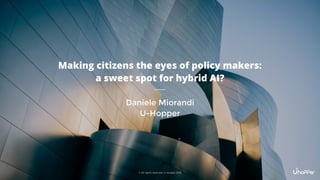
Making citizens the eyes of policy makers: a sweet spot for hybrid AI? (Daniele Miorandi, U-Hopper)
- 1. © All rights reserved, U-Hopper 2019 Making citizens the eyes of policy makers: a sweet spot for hybrid AI? Daniele Miorandi U-Hopper
- 2. © All rights reserved, U-Hopper 2019 Environmental governance • Policy- and decision-makers need data to take informed actions • Authoritative sources may be expensive to obtain (and hard of reach in developing countries) • Limited awareness and engagement of citizens hinder the impact of the policies/ actions The context
- 3. Can we involve citizens to provide data useful for environmental governance?
- 4. © All rights reserved, U-Hopper 2019 Tell me, I’ll forget Show me, I’ll remember Involve me, I’ll understand Why involving citizens?
- 5. © All rights reserved, U-Hopper 2019 Use (better: leverage) citizens as sensors • Many potential sensors! • Sensors that move (as people do) - finer spatial granularity • Finer temporal granularity • Free (well, kind of) Side benefits
- 6. © All rights reserved, U-Hopper 2019 • Crowdsourcing/crowdsensing as an established research field • Rather large body of literature • “Crowdsensing” returns 11,400 results on Google Scholar • Some well-known success stories • Related keyword: citizens science Is this really new?
- 7. © All rights reserved, U-Hopper 2019 Citizens' Observatories are community-based environmental monitoring and information systems. They build on innovative and novel Earth observation applications embedded in portable or mobile personal devices. This means that citizens can help and be engaged in observing our environment. An EU perspective
- 8. © All rights reserved, U-Hopper 2019 Laypeople using geiger meters to measure radioactivity in the Fukushima aftermath Over 50 million data points collected to date Example: Safecast
- 10. © All rights reserved, U-Hopper 2019 Citizen-generated data has quality issues • Noisy (low-cost sensors, non professional people, etc.) • Unreliable (no control on people, connectivity issues etc.) Data quality
- 11. © All rights reserved, U-Hopper 2019 Traditionally, policy and decision-maker in environment have been working with authoritative data sources • Fully trusted data of high quality • High availability Working with noisy, unreliable data
- 12. can AI help?
- 13. NO, not this AI
- 14. The ‘humble’ AI
- 16. Is AI fit for purpose?
- 17. © All rights reserved, U-Hopper 2018 Nothing can (yet) replace human intelligence at some tasks Can we use people to help AI when AI is not good enough? The missing piece: you
- 18. © All rights reserved, U-Hopper 2019 “Science which assists the needs and concerns of citizens” and “a form of science developed and enacted by the citizens themselves”. (Alan Irwin) Citizen science
- 19. © All rights reserved, U-Hopper 2019 A large community of volunteers supporting various citizen science projects across very diverse fields, such as space (astronomy), biology (biodiversity), geography etc, Typical task: image annotation Data: • 1,765,830 registered volunteers • 422,416,250 annotations generated Example: Zooniverse
- 20. Citizens (in situ) Portable sensors Mobile personal devices Citizens Observatory Citizen-generated data AI Data Quality Engine AI-annotated data Citizens (remote/online) Data to annotate Annotations Citizen-generated data with validated annotations
- 21. © All rights reserved, U-Hopper 2019 A large-scale initiative to demonstrate the viability of using citizen- generated information in river monitoring and flood prevention. SCENT engages citizens in environmental monitoring and enables them to become the ‘eyes’ of the policy makers. Focus on monitoring land-cover/use changes using citizens smartphones and tablets. Funded by EC within the H2020 framework The SCENT project @SCENT_EU scent-project.eu
- 22. © All rights reserved, U-Hopper 2019 Two large-scale pilots (Danube delta in Romania and Kifisos basin in Greece) Collected so far: • 13,939 citizen-generated images • 2,132 citizen-generated videos SCENT: pilots
- 23. © All rights reserved, U-Hopper 2019 SCENT context challenging for AI Need fine-grained classifications River bank with bare soil? With low grass? With high grass? Trees vs fruit trees? …
- 24. © All rights reserved, U-Hopper 2019 The creator signalled the presence of a water level meter The AI identified a bank river with low grass Both got invalidated in the final human intelligence stage Into the wild…
- 25. © All rights reserved, U-Hopper 2019 What AI said: • Fruit tree (99% confidence —> Passed) • Tree (92% confidence —> Passed) • River bank.Bare soil (74% confidence —> Validated) • Pasture/Grassland (49% confidence —> Invalidated) • River bank.Low grass (48% confidence —> Invalidated) More from the wild
- 26. © All rights reserved, U-Hopper 2019 Image creator signalled the presence of a water level indicator Confirmed by the AI But.. AI computed 2.0m depth :( Even more from the wild
- 27. © All rights reserved, U-Hopper 2019 Next step: use citizen-generated data to enrich data from Earth observations (e.g., Sentinel)
- 28. Citizens (in situ) Portable sensors Mobile personal devices Citizens Observatory Citizen-generated data AI Data Quality Engine AI-annotated data Citizens (remote/online) Data to annotate Annotations Citizen-generated data with validated annotations Harmonisation platform EOs data Data for policy- and decision-makers
- 29. © All rights reserved, U-Hopper 2019 Hybrid AI: artificial intelligence + collective intelligence as an approach for solving complex, wicked problems A lot of space for application in environmental monitoring/ environmental governance Do not reinvent the wheel • Protocols for user engagement • Software components (open source/Apache v.2) • Existing citizen science communities to tap in Summing it up
- 30. © All rights reserved, U-Hopper 2019 www.u-hopper.com Via Sanseverino 95 38122 - Trento, Italy Contacts Daniele Miorandi daniele.miorandi@u-hopper.com CEO +39 347 5865883 Get in touch if you want to run a project We can help!
- 31. © All rights reserved, U-Hopper 2019 Additional material
- 32. © All rights reserved, U-Hopper 2018 Extremely hard for AI Teams better than individuals at tackling them The level of diversity correlates with the effectiveness of solutions Wicked problems
